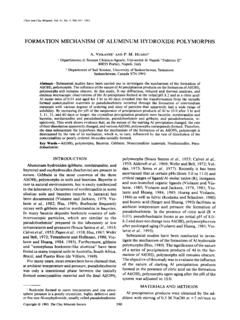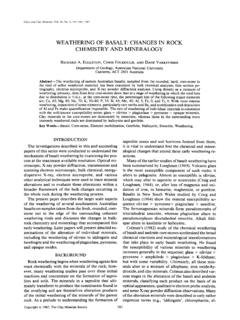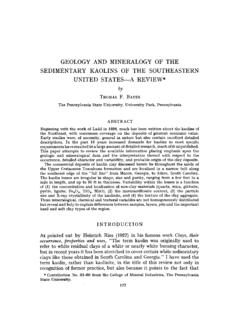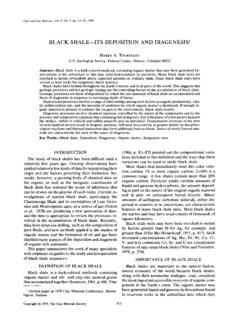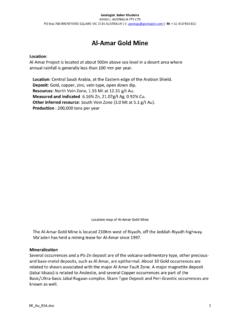Transcription of IDENTIFICATION OF KAOLIN MINERALS IN THE
1 IDENTIFICATION OF KAOLIN MINERALS IN THE PRESENCE OF chlorite BY X-RAY DIFFRACTION AND INFRARED ABSORPTION SPECTRA by HID~.o~ KoD~A* and KAORU OIN~ Tokyo University of Education, Tokyo, Japan ABSTRACT Experimental data are presented to show that the current auxilliary procedures adopted for IDENTIFICATION of kaolinite in the presence of chlorite are not generally valid because the procedures often fail to give an explicit condition for distinguishing both the MINERALS . As the result of an examination of numerous infrared spectra in the OH region of clay MINERALS , obtained by using Nippon Bunko DS-401G Grating Speetrophotometer, it turned out that the absorption band at 36984-2 cm -1 is effective for distinguishing kaolinite from other clay MINERALS without the use of any additional techniques.
2 The absorption band seems to be less affected by variation of particle size and erystallinlty than is the X-ray diffraction pattern. The band is detectable to a few weight percent of kaolinite in total amounts of clay MINERALS . IDENTIFICATION of kaolinite by its absorption spectrum in clay samples from sedimentary rocks was successful. INTRODUCTION In the course of studies on clay MINERALS in recent marine sediments and sedimentary rocks, we often encounter difficulty in IDENTIFICATION of kaolinite in the presence of chlorite by X-ray powder diffraction methods. In such a case additional techniques such as critical heat treatment and hydrochloric acid treatment are frequently used.
3 Though X-ray powder data obtained after these treatments provide valuable information for identifying kaolinite, it is often conditional because the treatments generally furl to give an explicit condition. The infrared method has not yet been applied to the above problem. Recently the writers examined in detail features of absorption bands in the hydroxyl region for each clay mineral and noticed an effective absorption band for distinguishing kaolinite from the other clay MINERALS . Consequently they could easily develop their research on this problem. The purpose of this paper is (1) to direct attention to the difficulty in obtaining useful differentiation by X-ray analysis involving additional * Present Address : Mineralogy Laboratory, Soft Research Institute, Canada Depart- ment of Agriculture, Ottawa, Ont.
4 236 IDENTIFICATION OF KAOLIN MINERALS 237 techniques and (2) to propose the use of an infrared method for rapid, exact and sensitive recognition of kaolinite. The writers wish to express their sincere thanks to Prof. Dr. Toshio Sudo of the Geological and Mineralogical Institute for his comments and also to Prof. Dr. Koji Nakanishi of the Chemical Institute for the use of spectro- photometers. CRITICISM OF X-RAY IDENTIFICATION METHODS Characteristic Reflections of Kaolinite In principle, detection of kaolinite is possible by the presence of 003 reflection, d = A, and 060 reflection, d = A. However, since the 003 reflection is fairly weak and the 060 reflection is often modified by 060 reflections from other dioctahedral MINERALS , the exact detection of small amounts of kaolinite admixed with chlorite and other MINERALS is very difficult.
5 In such cases the detection by the above reflections is indefinite. Thus, further analysis is necessary. Thermal Technique A combined thermal and X-ray method has been generally accepted as a method for distinguishing kaollnte and chlorite . However, as pointed out by Nelson and Roy (1953) (see also Brindley, 1961) there is a difficulty in this method in that a temperature (generally 600 ~ ~ 450~ and a length of heating period (generally 89 ~ 1 hr) used in the treatment, must be carefully chosen in accordance with particle size and degree of crystallinity. In addition, consideration must be given to variations in thermal behaviour of KAOLIN mineral varieties and chlorite mineral species.)
6 This statement is based on the following experimental results. By using the oscillating-heating X-ray powder diffraction method, an experiment was made on detailed thermal change of 001 and 002 chlorite reflections and of 001 kaolinite reflection. The reference specimens used are sedimentary and hydrothermal KAOLIN ]tes, dickite, ripidolite, leuehtenbergite and thuringite. They are well-crystallized materials except for sedimentary kaolinite with somewhat lower crystallinity. The intensity of each basal reflection was measured at intervals of 5 ~ to 10~ as the temperature was being raised 10~ per minute. Figures la and lb are graphs of the change in intensity of the basal reflection against the change of temperature.
7 In the experiments with the KAOLIN MINERALS , the 001 reflections disappeared entirely between 500 ~ and 720~ In the experiments with the chlorite MINERALS , the 002 reflections disappeared between 580 ~ and 660~ and the 001 reflections gave their maximum intensities between 610 ~ and 710~ Since these critical temperatures were measured in continuous heating experiment, the tempera- ture at which the basal reflection disappears tends to be somewhat lower if thermal treatment is maintained over a longer period of time. It is noteworthy that these experiments have produced varied behaviour and overlap of critical 238 ELEVENTH I~ATIO:NAL CONFERENCE ON CLAYS AND CLAY ~INERALS 800 / 700 z.
8 / 9 1/" / / ." 600 500 Ternpereture 1 ~ "~ 7 ~ reflection ' g 3 400 300 J .0 ! r ! \:i ! - i\ \f .. o ~ t W '" t iT,:,/\ /~" d 14,7 ~ refllcll .. [~ t ! /_~ / -:<- .. ~ ..L .. i7 .. /-.<" I /', ! 4 .l:-f T .. I .. i .. 800 700 600 500 "400 300 Temperature, FIGURE (a) The change in intensities of bhe 001 reflections of some kaolinites against the change of temperature. 1, Dickite (Kasuga Mine). 2, I-Iydrothermal kaolinite (Kampaku Mine). 3, Sedimentary kaolinite (Hara, Gifu Prcf.).--(b) The change in intensities of the 001 and 002 re- flections of some chlorites against the change of temperature. 1, Ripidolite (Hitachi Mine). 2, Leuchtenbergite (Wanibuehi Mine).]
9 3, Thuringlte (Ichino- koshi, Toyama Prefi). temperatures. Because of this, it is still more difficult to choose the best temperature for distinguishing kaolinite and chlorite . Hydrochloric Acid Dissolution Technique Hydrochloric acid treatment has often been used. In this treatment chlorite is decomposed, whereas kaolinite remains behind. This treatment is generally carried out with 6N hydrochloric acid in a boiling water bath. Though a poorly crystallized chlorite or iron-rich chlorite is easily decomposed by the treatment in a period of time as short as 10 rain, generally treatment for 1 hr is required to achieve complete decomposition of most chlorites.
10 However, according to Kobayashi and 0inuma (1961), experimental results suggest that it is difficult to choose with certainty the best period of time for treatment to differentiate between kaolinite and chlorite , regardless of variations of chemical composition and of erystaUinity. Therefore, the following case frequently comes into question. Figure 2 exemplifies X-ray diffraction patterns of four clay fractions from sedimentary rocks before and after hydrochloric acid treatment for one hour. All the patterns after treatment have no distinct ~ line, and have a N27 IDENTIFICATION OF KAOLIN ~/[INERALS Untreated. Treated, ,'~ ! l ..'-' s C 4 K 239 T022 A29 840J a.]

